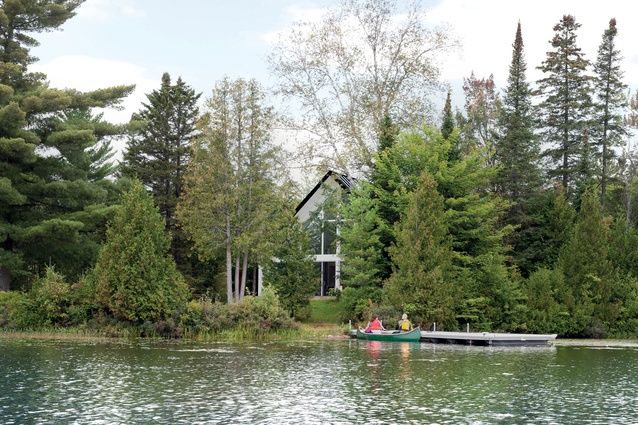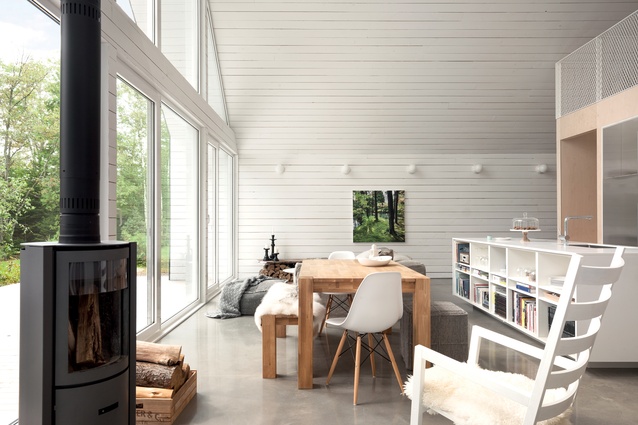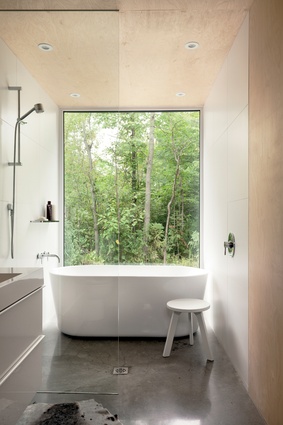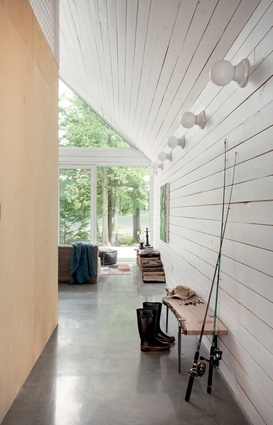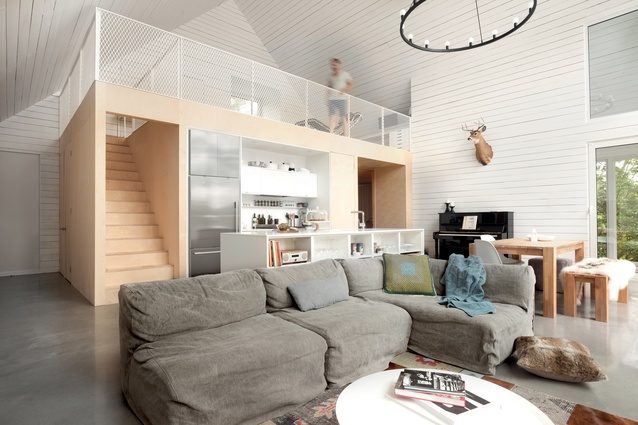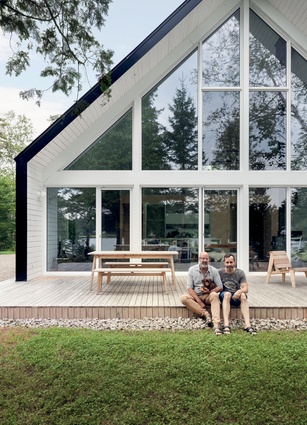Lakeside sojourns
This chalet beside a Canadian lake is built for relaxation, socialising and unabashed communion with nature.
Glimpsed through lush greenery on an impossibly idyllic lakeside site, this house plays with the idea of archetypes. Externally, it’s a monolithic A-frame standing 7.6 metres tall. Save for the occasional carefully placed window and a porch carved out of one corner, its form is almost cartoonishly simple – a silhouette of a chalet.
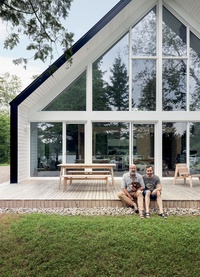
Of course, a form this simple demands meticulous refinement and a deft touch for spatial planning – two things the team at Montreal’s La SHED are well equipped to deliver. “In designing this project, we were conscious that the majority of houses nearby are fairly modest,” says Yannick Laurin, one of the founders of La SHED.
“The clients didn’t want the new project to clash with its neighbours and the surrounds. From that point on, we worked with the idea of a form that was simple and minimalist but resolutely contemporary.”
Located an hour or so north of Montreal, the Chalet de la Plage occupies a narrow site between a road and the shores of a lake. To preserve the owners’ privacy, the chalet turns its back on the road, presenting a discreet black-clad façade to the north. In contrast, its southern façade is a spectacular wall of glazing with views out over the water.
“We’ve created these rather generous overhangs over the glass façade: in summer, when the sun is very high, the eaves create shade and, in winter, when sun is lower, they still allow light and warmth into the house,” explains Laurin. This strategy floods the interior with natural light, allowing the concrete floor to act as a heat trap. Beyond the 130m2 building envelope, a wide deck of cedar slats surrounds it, becoming a kind of platform in the landscape.

The rigorous simplicity that drives the external form is evident in the interior, too. It is a single-vaulted volume into which a birch plywood box has been inserted. This box houses the enclosed rooms – a bathroom, a bedroom and a compact garage just large enough for a kayak and a motorbike.
Alongside the entrance, a walled staircase steps up the side of the ply volume to a flexible mezzanine space. On this first floor, a slimline desk slots under the slope of the ceiling, and the architects have designed a custom-made folding guest bed that can be stored underneath. Around the mezzanine’s perimeter an elegant screen of white steel mesh fulfils safety requirements without obscuring the view.
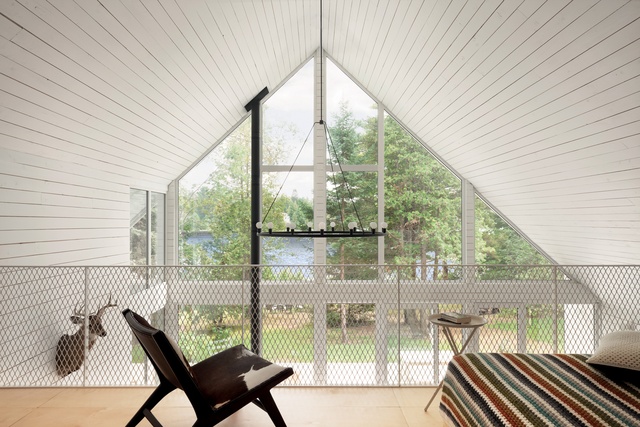
The streamlined kitchen takes centre stage in the main volume. It slots into the front of the ply volume, with a Corian-topped island bench connecting to the dining and living zones. A glazed verandah has been tucked into the eastern side of this space, with sliding glass walls that capture some of the house’s best views as well as providing access to the timber-wrapped spa outside. It is a serene spot.
Laurin describes the chalet form as a strong symbol within Canada’s collective conscious, and the interior includes some playful references to the traditional chalet typology. Below a taxidermy stag’s head, a rotating Stûv wood heater from Belgium can be angled to deliver heat where it’s required. Overhead, an elegant black steel chandelier in the shape of a wagon wheel combines modernity and nostalgia.
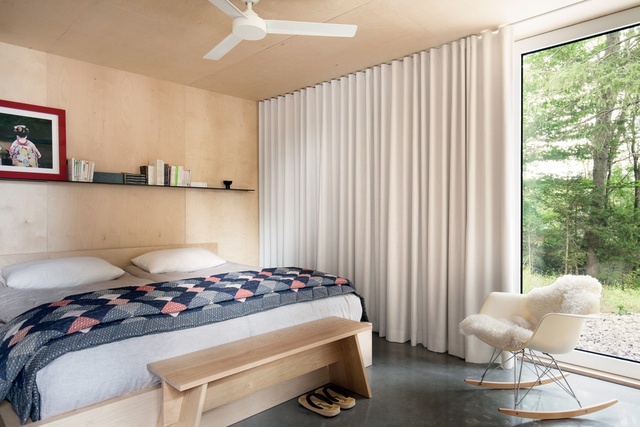
While the southern façade makes the most of the lake views, the architects made sure every room has its own carefully framed vista. On the mezzanine, a box window with a banquette seat looks out across the treetops; directly below, the two-person freestanding tub in the bathroom gazes through a full-height picture window to the trunks of the same trees. The bedroom – an intimate ply-wrapped cube – connects to the forested landscape through a glass wall.
The restraint of the built form shaped the material palette, too. The exterior is clad in ridged black steel. “We wanted a material palette that was fairly simple. This metal surface recalls the old roofing of traditional house forms in this region,” Laurin explains.
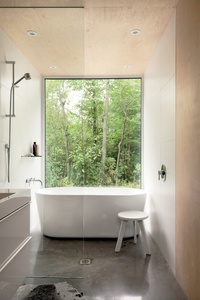
In contrast, the interior celebrates the warmth and texture of timber. “These qualities are enhanced by the contrast between the different materials and the different colours,” he continues. The walls and ceilings of the main volume are finished in horizontal slats of spruce, painted white but still revealing the whorls and imperfections of the woodgrain.
La SHED’s three young directors – Laurin and his former classmates Sébastien Parent and Renée Mailhot – have been earmarked as ones to watch in Quebec’s architectural scene. They established their nine-person studio in 2011 and, in 2016, received the Emerging Architectural Practice award from the Royal Architectural Institute of Canada. The jurors praised the team for the authenticity of their work, their strong urban signature and their sophisticated, inventive approach to architecture.
“While our architecture is contemporary, it also affirms our Quebecois cultural identity, through the use of materials and construction techniques that are typical of the region,” explains Laurin. “In a way, it’s vernacular architecture.”

